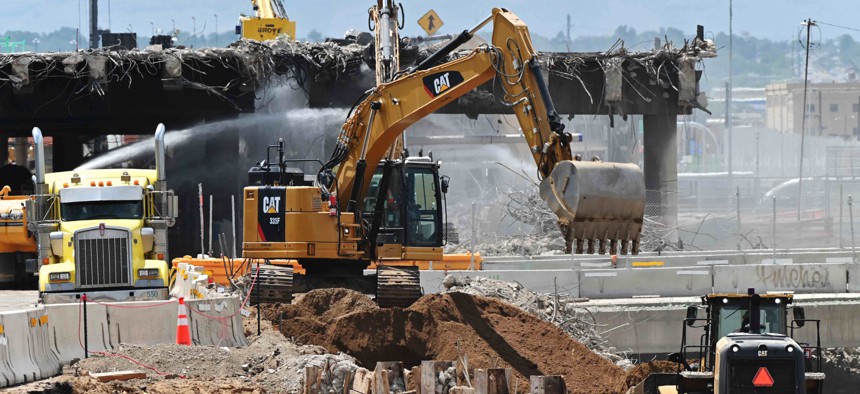The Infrastructure Law: ‘Hitting Timelines Without Cutting Corners’

: A shovel car demolish the old Interstate 70 viaduct near York St. in Denver, Colorado on Friday, July 9, 2021. Hyoung Chang/MediaNews Group/The Denver Post via Getty Images
Biden administration officials are pushing for projects to move quickly, while also meeting goals like benefiting disadvantaged neighborhoods and strengthening the nation’s workforce.
State and local officials can build ambitious projects paid for with the federal government’s $1.2 trillion infrastructure law while containing costs, keeping on schedule and delivering other benefits to the public, Biden administration officials assured industry experts Thursday.
Transportation Secretary Pete Buttigieg and several other administration officials hosted the White House event, sharing ways to keep projects “on time, on task and on budget.”
But federal officials, along with state and city leaders, also stressed that they could accomplish those tasks while training new workers, empowering people in disadvantaged neighborhoods, improving safety and consulting with the public about the design of projects before moving any dirt.
“President Biden has been very clear that he wants infrastructure to be delivered more quickly and efficiently than in the past, and importantly, to serve everyone in this country,” Buttigieg said. “This is about hitting timelines without cutting corners.”
Buttigieg said the redevelopment of Interstate 375 in downtown Detroit into a boulevard moved quickly through environmental reviews, because state and local officials had worked diligently to incorporate community suggestions into the project’s design.
The transportation secretary touted his department’s release of a new guide for states and cities to use in community engagement as they work on projects.
Maria Lehman, the president-elect of the American Society of Civil Engineers, worked on two bridges in New York state that went through the environmental review process in 13 months, an unusually short time.
She told participants at the White House event that talking with the public regularly was key to moving the projects along.
“You also have to think about how you don’t do things linearly. It can’t be in series. You can’t finish everything before you start the next process,” she said. “We can be very environmentally responsible about what we’re doing, provide equity and provide social justice. But you have to do it at once, all at the same time. And that’s not how we’ve delivered projects in the past.”
Community engagement can also help when it comes to keeping costs down, said Neil Pedersen, the executive director of the Transportation Research Board.
One reason why costs often escalate, Pederson said, is because elected leaders would later change the scope of the project to appease their constituents.
When he became the highway administrator for the Maryland Department of Transportation, Pedersen recalled, the governor’s chief of staff told him he had one chance to make a cost estimate for a major tollway project in the state. “Don’t blow it,” the chief of staff told him.
After his agency made an estimate, Pedersen said he talked to both the governor and the chief of staff. “You’re giving me responsibility for a cost estimate that I’m being held accountable for,” he remembered saying, “but you have to play your part in terms of helping me not continually be adding to the scope, and therefore the cost, continuing to increase as well.”
Tampa Mayor Jane Castor said another way that her city has helped contain costs is by using the progressive design build contracting process, where a builder works with the city to develop the project and then build it.
She said it was more efficient than the traditional method of design-bid-build, where different parties often clashed. “When something went wrong, everybody was finger pointing … and usually the one in the middle was a municipality that had to pick up the pieces and pay for the [overages],” she said.
Denver Mayor Michael Hancock stressed that projects could be completed on time and on budget while still addressing many of the other priorities that the Biden administration has pushed. He said the new money from the Infrastructure Investment and Jobs Act made that easier.
The new funding, he said, helped Colorado bring more benefits to a historically disadvantaged Denver neighborhood.
The extra money allowed the state to add more community-requested features to a project to expand a freeway through a poorer area on the north side of the city, he said.
The state is tearing down an aging viaduct and putting the new road in a wide trench. It originally planned on adding a park near a school over the new highway. With the federal infrastructure money in hand, the state is now adding several more bridges that will link neighborhood streets on either side of the highway, he said.
“Not only are we accelerating projects, but we are doing it under the guise and values of the Justice40 project going into these vulnerable communities and making things happen quickly,” he added, referring to the Biden administration’s effort to ensure that 40% of the infrastructure law’s benefits reach historically disadvantaged communities.
He said state and local leaders could develop projects that promote equity by laying out those expectations when they solicit bids for contractors or take in community input.
It’s on mayors, he said, to make it clear to contractors that it’s “not going to be business as usual” and that if they don’t come to the table with an “inclusive, equity mindset,” then they’re “not going to be a part of doing business.”






